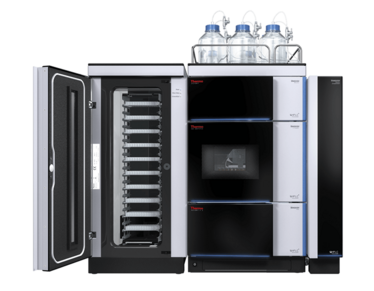Ultra-Engineering UHPLC from Scratch
Incremental improvements to ultra-high performance liquid chromatography (UHPLC) have failed to deliver the tangible advances that researchers really want. Sometimes, a full overhaul by re-engineering from the bottom-up is the only way to innovate and move the field forward.
sponsored by Thermo Fisher Scientific

Graduating with a B.S. in Microbiology, Kevin McCowen confessed that he didn’t know a lot about analytical science when he took an interview for an entry level QC chemist role. The company decided that he was a cultural fit and would be worth taking a risk on training. Sixteen years later, he is an associate scientist in analytical development at Ajinomoto Althea in San Diego – and he can’t get enough of analytical science, particularly biotherapeutic characterization.
Althea is a biologics contract development and manufacturing organization. The main role of the Analytical Development department is to support its clients’ drug programs, but the Analytical Development team also likes to take on independent projects (particularly with partners) that allow them to exercise not only their knowledge of biophysical characterization, but also regulatory requirements. “I am constantly looking for a challenge, so a field like biopharmaceuticals is well suited for my need to expand and explore,” says Associate Scientist, Kevin McCowen. “And I get to apply a variety of different techniques. I might start with HPLC, but if I see something interesting I might look at it further using Fourier transform infrared spectroscopy, and then I might do an ELISA for functional characterization. I enjoy thinking about a problem and looking for a solution that is multifaceted.”
And although Althea’s Analytical Development lab has a number of techniques in its analytical toolbox, UHPLC is one that McCowen is particularly excited about because it removes the need for the HPLC-associated trade-off between sensitivity, speed and resolution.

Putting the ULTRA back into UHPLC
When UHPLC systems were first introduced, they were faster and offered higher throughput than standard HPLC systems, but there were also a number of teething issues, including system robustness, complicated method transfer, and reproducibility concerns. Efforts were made to address these issues, but according to Jeanine Pippitt, Regional Marketing Manager for Thermo Fisher Scientific, the industry mindset tended to veer towards incremental improvements over instrument revolution. However, if you fix one problem at a time, you may cause further (and sometimes new) problems. For example, providing the system with a higher pressure pump can damage the injector; and developing an injector compatible with the new pump may cause column problems. “I think a lot of incremental improvements that we’ve seen in UHPLC systems were actually more like a series of band-aids,” says Pippitt. “We wanted to do better.”
The Althea Analytical Development lab recently took delivery of a Thermo ScientificTM VanquishTM UHPLC System. “When instruments evolve, it’s always interesting to see what new challenges the technology will allow us to solve,” says McCowen. “We are working on transferring an amino acid method to the Vanquish UHPLC System, and we’ve been able to achieve faster separations as well as good resolution. As a practical example, we’ve been able to resolve leucine from isoleucine while decreasing the run time by half – without putting a lot of effort into method development.”
And, despite initial skepticism, Pippitt certainly has no doubts about the capabilities of the system. “When I first saw the data on the Vanquish UHPLC System, I almost didn’t believe the chromatography presented in the literature. I thought it was just marketing fluff. It’s not.”
Analytical advances – engineered
“We didn’t want our system to offer an incremental increase above other systems. We designed it from the bottom up and looked for the best technology – from whatever industry – for each UHPLC feature,” says Pippitt. “We rejected industry-standard column injectors, and instead developed a device which meters samples with better precision. Similarly, we tried to find the best pumping technology, construct robust valves with diamond-like coatings, use ‘fingertight’ fittings with zero dead volumes, produce a detector with the highest sensitivity and build in a continuous flow of solvent to wash the needle. Developing a system that delivers uncompromised UHPLC – no trade off in performance, robustness and ease of use.”
As a development lab, McCowen’s group is expected to work with clients to solve difficult problems related to biotherapeutic characterization, which goes beyond simply analyzing a sample and sending back the data. In many instances, clients are working to tight timelines. “UHPLC instruments such as the Vanquish are helping us to turn around data in a short period of time. I think that the increased speed and resolution have made the biggest impact so far, but it’s still a new addition to the lab,” says McCowen. “We’re still investigating different column temperature control modes and pre-column compression capability – and how they affect separations of larger proteins.”
“In a busy lab, systems need to be easy to use and maintain,” adds McCowen. “For example, it’s easier to track column use and performance. Another factor that’s important in labs today is space. Instruments designed to be stackable help address this issue. What I really liked with the Vanquish UHPLC System is that the mechanics can be slid out of the housing on rollers – just like a drawer. As a bonus, it also looks like something NASA might like to use...”
“Kevin has also been exploiting the extended sample capacity afforded by the Thermo ScientificTM VanquishTM Charger module, allowing increased sample analysis capacity while maintaining the samples at the same conditions as the autosampler; the Charger module is integrated into the autosampler as an add-on,” says Pippitt. Unlike other systems, the sample extension is aligned well with software and bar code readers so that there’s never a sample missed.
Since the Vanquish UHPLC System is a relatively recent addition to the Althea Analytical Development lab, the team is still experimenting with its potential and investigating how certain features (such as the two different methods of temperature control and the pre-column compression) can affect separations. “We’ve already started working on some projects that we hope to publish. I can’t give too many details away, but I will say that we’re planning to take full advantage of all of the column heating mechanisms and detector capabilities to do that work,” says McCowen. “And we’ve been using the Thermo ScientificTM DionexTM ChromeleonTM Chromatography Data System to help us keep things in order – and ensure that our data are meeting compliance guidelines.”
Analytical crystal ball gazing
What does the future of biotherapeutic characterization and instrumentation hold? McCowen and Pippitt are unsure of how accurately the future can be predicted. McCowen says, “If you’d asked me about the future 15 years ago, I would have given you the wrong answer. I never would have imagined that a mass spectrometer that fits on a bench top could rival the data coming out of the system I was using back then, which had a magnet so large that a room had to be built around it!”
“Speed, sensitivity and specificity will always be crucial aspects – so I can definitely say that they will continue to advance in both LC and MS technology,” says Pippitt. “But right now, the Vanquish UHPLC System is pushing those limits of sensitivity, speed, resolution and retention time precision. In fact, when I demo our system side-by-side with a lab’s existing set-up and their application, some customers ask us to leave the demo machines with them...”
Overall, McCowen believes that the move to UHPLC has significantly increased his lab’s analytical capability. “The trend towards more automation is also changing how we work. But the most important thing is that technology should evolve for the right reasons. Incremental changes aren’t always what researchers want. Real evolution should build on what we already know – it shouldn’t be like having a dial on a guitar amplifier that goes to 11, even though we can’t really make 11 any louder...”



















